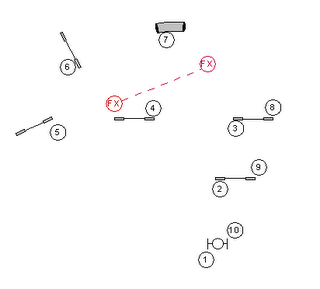
At class last night we worked on tyres and tunnels, neither of which Dusty has any problem with, and on tightening turns, and we did some start-line stay practice.
With Thommo I do a stand stay. This seemed to be the position he was most comfortable with, probably as a result of playing Ready, Set, Go games where he would be standing beside me, and of many hours of him standing and waiting while a threw a ball, then gave the OK to fetch.
With Dusty I'm using a down stay at the start, again because this seems to be a default behaviour for her, and one the first stay we learned as she needed to do a down stay in the presence of sheep to get her Herding Instinct Certificate. I guess I could insist on a sit-stay with either of them, and work to reinforce it and proof it. But why not start from a position they are already comfortable with.
There is some debate over what is the fastest start. Nancy Geyes recommends a sit-stay, saying that she finds it easier to teach a reliable, square, sit-stay, than a stay in a stand or down position. Chris Zink says that dogs that are left standing at the line first trot and then have to shift into a canter before jumping (jumping is an extension of the canter). This wastes some time and also makes it more difficult for the dogs to judge the correct take-off point. In contrast, dogs that are left sitting go straight into a canter and are ready to jump without having to shift into a different gait.
This may be true where the dog stands flat footed, or lies down belly on the ground, but my dogs wait in a sort of crouch: Thommo in a stand slightly lowered, Dusty in a down slightly raised. Most herding dogs adopt this sort of pose in a wait.
Greg Derrett advocates a standing start. He also says to have a routine which incorporates the dog's natural behaviour. He brings the dog to the start line then stands them with a gentle scruff.
No comments:
Post a Comment